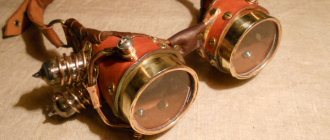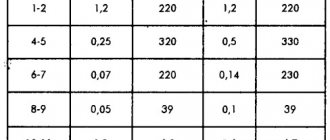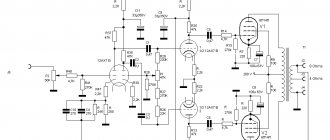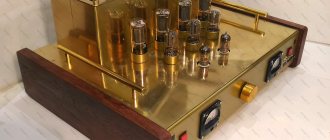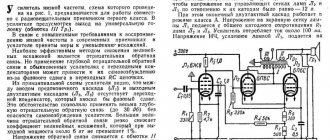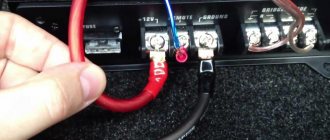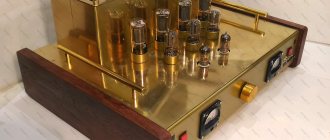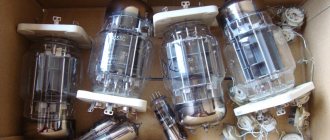The article discusses the technical characteristics of the 6N2P electron tube, which is a miniature double triode. The first versions of this device appeared in the 50s and since then their design has not changed fundamentally. The main purpose is to amplify low frequency voltage. Until the mid-70s, it was used to create radio receivers, transmitters, televisions, etc. It is believed that the prototype for its development in the Soviet Union was the American 12AX7WA radio tube.
It is interesting that to this day the 6N2P lamp continues to be produced and is used by Russian manufacturers when creating audio equipment using radio tubes. She is well known among rock music fans. It is used mainly in guitar amplifiers, namely in preliminary amplification stages, on which the quality of the reproduced music directly depends. It has a relatively neutral tone when overdriven and is relatively transparent when clean. There are endless debates on Internet forums about its characteristics and sound capabilities in various frequency ranges.
Main characteristics
To operate 6N2P, a constant or alternating filament voltage is used in the range from 5.7 to 6.3 V. Underestimating or overestimating this parameter leads to destruction of the cathode over time. Therefore, it is desirable that the power supply be stabilized and provide a soft start. It is better that it does not exceed the lower rated values, which ultimately can significantly extend the life of the lamp.
Operating data
Here are the main operational characteristics of the 6N2P:
- voltage: filament 5.7 to 7.0 V;
- constant anode from 250 V (nominal) to 300 V;
- between the cathode and the heater – up to 100 V; between anodes – up to 2 V;
- grids - minus 1.5 V (constant);
- filament - 340 ±25 mA;
capacity:
- between anodes – no more than 0.15 pF;
- between the cathode and the heater – no more than 5 pF;
- capacitance (for each triode): input - 2.35 ±0.35 pF; output 2.5 ±0.5 pF; pass-through – 0.7 ... 0.8 pF;
- characteristic slope – 2.1 +0.5 mA/V (each triode);
- gain – 97.5 ± 17.5 (each triode).
It is worth noting that these parameters are indicated by the manufacturer in the technical description (datasheet) exclusively for the lamp warmed up to operating condition. When connecting the filament to alternating current, to reduce the background by 25-30 dB, it is recommended to apply no more than ±10 V between the cathode and the heater.
Analogs
It is well known that the 6N2P has a good foreign analogue, which served as a prototype for its creation - 12AX7WA. However, the latter still has slightly different parameters, and even a superficial examination of the datasheet shows differences in the values of the filament voltage and pinout. Despite such discrepancies, many guitar lovers, in search of better sound from their amplifiers, use these tubes as a replacement.
In such cases, we can recommend the European versions of ECC83, ECC89 from Tesla, which are no worse than the American one. Unfortunately, such radio tubes, like the 12AX7WA, are currently quite difficult to find in Russian stores and, moreover, they are very expensive. Therefore, some radio amateurs are modifying to install Soviet 6N2P instead. An example of such a modification is shown in the video.
Many online forums discuss the possible replacement of 6N2P with 6N3P, and there is debate about which lamp is better. However, these two radio tubes are different in their characteristics. In addition, the latter has a lower current gain and a different pinout. In most cases, replacing one device with another will require a deep reworking of the existing circuit.
A complete domestic analogue can usually be called 6N2P-EP - this later modification of the lamp under consideration is considered a good alternative. The functional analogue is considered to be 6N9S, which is completely identical in parameters, but the location of its pins is still different. To install the latter instead of 6N2P, you need to come up with an adapter or resolder the circuit.
6P3S, 6L6
6П3С Datasheet 6L6 RCA Datasheet
Tell me, until what year were 6L6 metal lamps produced by RCA and KEN-RAD (the latter until the 60s?) and is it worth dealing with them (specifically metal ones)? Igor.
A considerable number of especially American lamps of various types were first produced in metal and then in glass “design”. I think these lamps will be from the 40s or 50s. I somehow prefer glass ones, and they are more valuable than metal ones. Otherwise it would be better to listen to them and decide for yourself. Girius
I think it’s a good lamp, if from the 50s–60s then one of the best, at the RCA level. Girius
> What are some reviews (or listening impressions)
> glass 6L6 GC General Electric (USA), compared to
> other manufacturers?
Do my metal 6L6s haunt you? Well, they won’t be there any time soon. There will be one fucking remake. And you still suffer. How they sound - yes, it’s almost equally good whether KEN-RAD or RCA. If we figuratively compare it with the usual 6P3S, it’s as if the 6P14S was stuck in - soft with a slightly sweet aftertaste, warm and velvety. Maybe the usual dynamics and sharpness are not enough, but it’s so “vintage” or something, like a radio from the 50s and the middle is so big and fleshy. I even decided to leave myself one pair for the 34s from Telefunken, they fit me instead of the EL34s - they fit the mode (I did this on purpose for myself...) I listen to records from the 50s on them.
> Are there any Svetlanovskys by any chance? They were produced specifically for
> SVD, I bet they will beat RCA, although as far as I know,
> this is the same thing, ours did it under their license... But it’s interesting
> it would be comparable.
Such a chance never presented itself... NO! But the fact that they will beat RCA or KEN-RAD - I think you’ve had enough. Eggs (Svetlana) do not teach chicken (RCA). In addition, my glands are also “military” - with the label JAN.
Question. How are 6L6s so different from the old Moscow 6P3S?
> It’s best to immediately replace it with 6L6 and install 400V 50-
> 55mA
The above-mentioned 6P3S do not hold their 20W for very long. at the anode. And 6L6, presumably, is more reliable?
> Better yet, 6v6 with the same voltage, but less current -
> 35–40mA, there will be little power, but there will be a lot of sound...
Likewise. How are 6V6 different from the old Moscow 6P6S? I mean, how long?
> If you need power, 6550 (KT88) is the same voltage, 80mA.
> Thirty-four smokes bamboo in any case, and
> inhale. IMHO the place for the thirty-four is only in guitars
> combos.
And what exactly does it smoke in comparison with the above-mentioned 6550, 6P3S and 6P6S-similar in sound? And what exactly are 34? If possible, in more detail. Best regards, Sergey Rubtsov.
> Question. What is the difference between 6L6 and 6P3S?
> Moscow old ones?
I haven't tried 6P3S.
> The above-mentioned 6P3S do not hold their 20W for very long. on
> anode. And 6L6, presumably, is more reliable?
Apparently yes. There were no problems.
> Likewise. What is the difference between 6V6 and 6P6S of old?
> Moscow? I mean, how long?
These last a long time and are very good. Exactly the old Moscow ones.
> And what exactly does she smoke in comparison with the above-mentioned 6550,
> 6P3S and 6P6S-similar in sound? And what exactly are 34s?
> If possible, in more detail.
Siemens, Svetlana, Reflector... They are doing something with sound... In general, this is already the third round of discussion, if my memory serves me right. Eugen.
Don't be afraid - stick freely into both. 6P3S play more down to earth, with larger strokes or something, and with a more refined top and a drier bass. Although their midrange is more powerful and sometimes even more pleasant on some music. But the analogue of 6P3S (5881) - the US stingy 6L6 - is a slightly different story. I’m plowing instead of 34 right now. Not Telefunken kanechna, but very, very! Retro style
> Please tell me which 6L6 is preferable for
> other conditions being equal:
> RCA or KEN-RAD? There is a difference, what is it?
> expressed?
> Thank you, Igor.
It's hard to recommend in absentia, but I'll try. Without looking - I would recommend Kenrad - this company existed until about 60, so the lamp will be old, with a good sound, and I do not know a single lamp from this company even with an average sound - everything is only good or excellent. With RCA it’s more difficult, depending on your luck - at best it will be a little better than Kenrad, and at worst it will be much worse. Girius
Maybe a little off topic, but since all these lamps are relatives (near or distant), let me say the following. About 3 years ago Volodya Zimakov fitted me with 3 6L6GA Tungsrams from 1964. So, the way they sound (I compare with different pentodes, naturally in triode connection), not a single lamp sounded. Such volume and transparency, excellent stage depth, etc. In my opinion, it is the 6L6 with different letters (I also really like the letters WXT) from this family that are most preferable in a single-ended amplifier. I would put 6P3S (without E) in second place, and EL34 in third. I'm talking about a single-ended amplifier, because in a push-pull amplifier I would put the EL34 first. These are my preferences, maybe they will be useful to someone. Best regards, Vadim Puzanov.
Colleagues, on my lamps it is written: 5881 WXT SOVTEK 02 02. The diameter of the bulb is 37 mm. 6P3S has a diameter of 34 mm. 5881 has an anode that is 5 mm smaller in height, but much wider in diameter. The G807 has the same anode as the 6P3S, but there is no perforation on the sides, but ceramic bushings are installed everywhere. We are all Kulibins. Maybe they took the American 5881 and improved it (?) and called it 6P3S-E, then relabeled it back to 5881. illarionovsp
The old ones in the Cobra cylinder, with a black anode, from the very early 50s, play very well. Much better than the Saratov 6P3S of the 60s. And not only jazz Shalin
But when I made amplifiers using pentodes (for example, 6L6), there was a clear improvement in sound when the current (corresponding to the dissipation power) through the lamp increased. For example, with a current rating of 72mA, I brought it to 82mA. Thus, one of the lamp modes (current) was exceeded. The sound became denser and more voluminous. Vadim Puzanov
Just in case no one is familiar with the American development of the 6L6, here's some info
6L6 – metal, originally cork
6L6G – large glass globe, same ratings as 6L6
6L6GA – smaller glass globe, same ratings as 6L6 6L6GB – small tubular globe, same ratings as 6L6
6L6GC – larger tubular globe, higher anode dissapation rating, and rated voltage. Very common in audio amplifiers from y9b0s – present
KT66 – British version of 6L6G
7581A – American copy of KT66 (basically 6L6GC)
7027 – RCA's attempt to compete with the Mullard EL34 by putting the 6L6 in a nice new package option
807 – 6L6 made for radio transmitters, with a 5 base pin, and an anode cap for a higher rated voltage
5933 anodes – (very) improved 807
It seems that your 6P3C globe shape is also made in China - I have a couple of them, but they don't give any high quality display. Max H
Again, this is just my opinion. The 6L6 sounds surprisingly sweet in the mid-high frequency range. I would say tenderly, although I don’t use such terms. And in the low-frequency range there is very good articulation. Not a buzz, but a low note. To summarize, the sound is more collected and dense. Vadim Puzanov
Group No. 1 is represented mainly by versions of the ancestor of beam tetrodes, 6L6, developed in 1936 by RCA engineer OH Schade [1]. The lamp, in terms of its totality of properties, turned out to be so successful that it has been mass-produced (!) both in the form of versions close to the original design and in the form of modifications for 70 years. During this time, more than a billion copies of the 6L6 and its clones were produced. No other output vacuum tube in the world has been produced in mass quantities for such a long period of time. What is the reason for such a long and successful life of this lamp? A careful study of the material “Beam Power Tubes” [2] allows us to partially answer this question. Firstly, this is a unique combination of electrical parameters. The lamp has a fairly high anode dissipation power (20 W) and a high emission current (up to 250...300 mA with a positive potential on the control grid) with a very economical filament circuit (only 5.7 W). That is, the thermion emission efficiency coefficient (the ratio of the permissible power dissipation of the anode together with the second grid to the power consumed by the filament circuit), amounting to ETE = 3.86 for the original version of the lamp, was and still remains very high for indirectly heated lamps. Moreover, the 6L6GC version with increased power dissipation on the anode and the second grid has an ETE value of 6.14, which to this day has not been surpassed by any of the indirectly heated output receiving and amplifying lamps. The pass-through characteristic of the lamp has a very weak upper bend, this determines the low level of odd harmonics in the distortion spectrum of the 6L6 cascades (in optimal load mode, the second harmonic is approximately four times higher than the third and 12 times higher than the fifth [2]). This property makes 6L6 very attractive for building push-pull amplifiers in which even-numbered harmonics are suppressed. In addition, the harmonic spectrum of the 6L6 and its versions falls off quickly, unlike most other output pentodes and beam tetrodes, which also determines the low order of the combination components when amplifying multi-frequency signals [3]. Several years after the start of production of the 6L6, it became clear that the device has good high-frequency properties and can be used to amplify and generate signals at frequencies up to 100...150 MHz. Reliable designs of the control and screen grids allowed for significant thermal loads and, accordingly, the ability to operate in modes C and BC with control grid currents. A special high-frequency version of the lamp was also developed, characterized by improved insulation of the anode, its output to the top of the cylinder and a deeper vacuum, which made it possible to increase the operating voltage at the anode to 600V. This version received the status of a generator lamp and its own name - 807 [4]. The reliability of the 6L6 turned out to be very high, even in modes close to the limit and under mechanical influences, the lamps worked significantly longer than their fellow pentodes 6F6 and 837. Already in the 4th year of production, a version of the lamp with a 3000-hour 90% rating was introduced resource, and subsequently – with a 10,000-hour resource (5881). The rather weak microphone effect made the 6L6 an extremely popular amplifier tube for electroacoustic units in which the loudspeaker and amplifier were located in the same housing. The current representatives of such devices - guitar amplifiers - “combos” are still in many cases made using 6L6 tubes and their versions in the final stage; they are used by such monsters of the musical instrument industry as Fender and Gibson. Another reason musicians love this lamp is the ability to work both in linear mode, with very low distortion, and in overload mode, “overdrive,” when distortion increases sharply, but the overload itself does not pose a danger to the lamp. There is also a “smaller” version of the 6L6, like its half, the 6V6 beam tetrode. While retaining many of the positive qualities of its “big sister,” 6V6, with half the permissible dissipation power at the anode, has smaller interelectrode capacitances and works better in high-frequency and pulsed devices when significant power output is not required. After World War II, a number of companies developed modernized versions of the 6L6, distinguished by extreme parameters, mechanical performance and reliability. The most successful of all should be recognized as the 6L6GC lamp (RCA, 1951), which fully retains all the characteristics of the 6L6, including interelectrode capacitances, but allows one and a half times more power dissipation at the anode (30 W versus 20 W for the 6L6) and twice the the larger one is on the screen grid (5 W versus 2.5 W). The grid characteristics of 6L6 lamps have a significant opening (somewhat similar to the extended characteristics of pentodes for cascades with variable gain) and anode current cutoff does not occur even with significant negative potentials on the control grid. This means that in a push-pull cascade there will be no sharp cutoff of the anode currents of the arms, which is favorable for the operation of the output transformer from the point of view of nonlinear distortions caused by non-stationary processes in the output transformer in the presence of cutoff [5]. It was decided to use tubes of this particular type in the output stage of the amplifier. From a pair of 6L6GCs you can freely obtain power up to 45...50 W [6], without entering the region of control grid currents at voltages on the anode and screen grid significantly less than the maximum permissible. The rated output power in the load is chosen to be 35 W, which, taking into account losses in the output transformer, requires a power output of 38...42 W from the cascade. It is better to use a fixed bias on the output stage lamp grids. In this case, for the push-pull cascade to operate, two antiphase signals of equal amplitude are required, which are formed in the bass reflex cascade. lynx
Well, today I read your article about the new amplifier. As for me, this is a completely normal amplifier, I, too, by the way, am a supporter of differential phase inverters..... but what surprised me was the reasoning about the choice of end lamps. The fact is that I assembled amplifiers based on both the 6L6GC and the EL-34, and also had experience in replacing tubes in factory amplifiers, and what I noticed was that ALWAYS, in all variants, the EL-34s won. Moreover, they won even when they were installed in an amplifier originally designed for 6L6. Even then they won when I put them in a big old 100-watt Fender amp. The effect in the combo was simply striking, to be honest. The sound of 6L6 has always been distinguished by some kind of excessive “softness”, sometimes even turning into “sweetness”..... as if they lacked energy, or something. And their bass is kind of sluggish. Therefore, I am definitely a fan of the EL-34 in classic push-pull circuits, and by the way, I agree that it is better to turn them on with a pentode. That’s why I would be interested to know what your opinion is about the best sound qualities of 6L6-like lamps? In what schemes did you compare them with “Christmas trees”? demon
I really like it. I liked the 6L6S from Groove Tubes. I compared it with many “similar” ones and settled on them. They run in SE in parallel (matched pairs), in the build-up E182CC andy911
